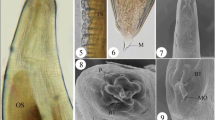Abstract
Anisakis simplex IgE may bring on allergic responses such as angioedema, vomiting, and urticaria from eating seafood, but it is not the only etiology. Induced cholinergic hyperreactivity or adrenergic blockade in the target tissue can cause these diseases nonimmunologically also. Here we studied the effects on normal intestinal motility of brief A. simplex infections and in vitro exposures to the parasite's extract (CE). Each approach was evaluated according to its ability to induce cholinergic hyperreactivity or adrenergic blockade in rat duodenum (RD), jejunum (RJ), and ileum (RI) in vitro. Additionally, bolus propulsion in RD, RJ, and RI was evaluated with time in vivo utilizing animals infected 4 h previously with A. simplex larvae (L3) vs sham animals. Tissues, after inoculation of 1, 5, 10, and 20 L3, exhibited time- and dose-dependent motility changes after carbachol (Ch) and noradrenaline (NA), justifying our using herein rats from the fourth hour of infection with 20 L3. We observed a persistent, yet differential effect of the infection on RD, RJ, and RI responses to Ch or NA. It caused cholinergic (muscarinic) hyperreactivity in RD only, and adrenergic blockade in all other parts, and consequently increased the transit index in RD, not in RJ or RI. In contrast, exposing RD, RJ, and RI to CE persistently increased both parameters, amplitude of twitches and muscular tone, in all, albeit that, here also, responses to Ch and NA were CE dose dependent. Interestingly, sensitivity to CE was in the order RI > RJ > RD, the reverse situation of that observed during active infection. Thus, previously viable A. simplex L3, after digestion, can exert bystander disturbance in autonomic control in the whole intestine. Our findings demonstrate that A. simplex L3, alive or dead, can induce cholinergic hyperactivity and adrenergic blockade in the whole small intestine and, as a consequence, gastrointestinal symptoms. Significantly, they may do so long before parasite-specific IgE is detectably induced or despite the occurrence of such IgE.
Similar content being viewed by others
References
Itshikura H, Kikuchi K, Nagasawa K, Ooiwa T, Takamiya H, Sato N, Sugane K: Anisakidae and anisakidosis. In Progress in Clinical Parasitology, Vol III. T Sun (ed). Berlin, Heidelberg, Springer, 1993, pp 43-102
Jones RE, Deardorff TL, Kayes SG: Anisakis simplex: histological changes in experimentally infected CBA/J mice. Exp Parasitol 70:305-313, 1990
Perteguer MJ, Cuéllar C: Isotype specific immune responses in murine experimental anisakiasis. J Vet Med B 45:603-610, 1998
Van Thiel PH, Kupers FC, Roskam RTH: A nematode parasitic to herring causing acute abdominal syndromes in man. Trop Geogr Med 2:97-113, 1960
Kennedy MW: Immune responses to Anisakis simplex and other ascarid nematodes. Allergy 55 (Suppl 59):7-13, 2000
Bell RG: The generation and expression of immunity to Trichinella spiralis in laboratory rodents. Adv Parsitol 41:149-217, 1998
Audicana MT, Ansotegui IJ, Fernández de Corres L, Kennedy, W: Anisakis simplex: Dangerous—dead and alive? Trends Parasitol 18:20-25, 2002
Domínguez-Ortega J, Martínez-Cócera, C: Guía de actuación en patología producida por Anisakis [Guidelines in pathology induced by Anisakis]. Alergol Inmunol Clin 15:267-272, 2000.
Perteguer MJ, Chivato T, Montoro A, Cuéllar C, Mateos JM, Laguna R: Specific and total IgE in patients with recurrent, acute urticaria caused by Anisakis simplex. Ann Trop Med Parasitol 94:259-268, 2000
Cuéllar C, Perteguer MJ, Rodero M: Presence of IL-4-like molecules in larval excretory-secretory products and crude extracts from Anisakis simplex. Scand J Immunol 53:483-488, 2001
Terr AI: Mechanisms of hypersensitivity. In Medical Immunology, 9th ed. DP Stites, AI Terr, TG Parslow (eds). Upper Saddle River, NJ, Prentice—Hall International, 1997, pp 376-388
Vázquez-López C, de Armas-Serra C, Rivera L, de la Villa P, Rodríguez-Caabeiro, F: Effect of Gymnorhynchus gigas plerocercoid crude extract on the rat ileum motility “in vitro.” Int J Food Microbiol (in press)
Lowry OH, Rosebrough NJ, Farr AL, Randall RJ: Protein measurement with the Folin phenol reagent. J Biol Chem 193:265-275, 1951
Pichler WJ: Anisakiasis: Immunity, allergy or both? Lessons on the natural role of immunoglobulin E from a nematode infestation. Clin Exp Allergy 29:1161-1163, 1999
Schultheiss G, Diener M: Inhibition of spontaneous smooth muscle contractions in rat and rabbit intestine by blockers of the thromboxane A2 pathway. J Vet Med A 46:123-131, 1999
Vázquez-López C, de Armas-Serra C, Bernadina W, Rodríguez-Caabeiro F: Oral inoculation with Gymnorhynchus gigas induces anti-parasite anaphylactic antibody production in both mice and rats and adverse reactions in challenge mice. Int J Food Microbiol 64:307-315, 2002
Foster N, Dean EJ, Lee DL: The effect of homogenates and excretory/secretory products of Nippostrongylus brasiliensis and of acetylcholinesterase on the amplitude and frequency of contraction of uninfected rat intestine “in vitro.” Parasitology 108:453-459, 1994
Foster N, Lee DL: A vasoactive intestinal polypeptide-like protein excreted/secreted by Nippostrongylus brasiliensis and its effect on contraction of uninfected rat intestine. Parasitology 112:97-104, 1996
Sakanari J, McKerrow J: Identification of the secreted neutral proteases from Anisakis simplex. J Parasitol 76:625-630, 1990
Vázquez-López C, de Armas-Serra C, Giménez-Pardo C, Rodríguez-Caabeiro F: Proteolytic activity of the Gymnorhynchus gigas plerocercoid: purification and properties of a collagenase from the crude extract. Parasitol Res 85:64-70, 1999
Sajid M, McKerrow JH: Cysteine proteases of parasitic organisms. Mol Biochem Parasitol 120:1-21, 2002
Liew FY: The role of nitric oxide in parasitic diseases. Ann Trop Med Parasitol 87:637-642, 1993
Cuéllar C, Perteguer, MJ, de las Heras B: Effects of Anisakis simplex on nitric oxide production in J774 macrophages. Scand J Infect Dis 30:603-606, 1998
Author information
Authors and Affiliations
Rights and permissions
About this article
Cite this article
Sánchez-Monsálvez, I., De Armas-Serrá, C., Bernadina, W. et al. Altered Autonomic Control in Rat Intestine Due to Both Infection with Anisakis simplex and Incubation with the Parasite's Crude Extract. Dig Dis Sci 48, 2342–2352 (2003). https://doi.org/10.1023/B:DDAS.0000007873.48287.f6
Issue Date:
DOI: https://doi.org/10.1023/B:DDAS.0000007873.48287.f6




